A New Multidimensional Repulsive Potential Field to Avoid Obstacles by Nonholonomic UAVs in Dynamic Environments
Abstract
:1. Introduction
2. Design of the Multidimensional Repulsive Potential Field
3. Numerical Simulations of Typical Collision Scenarios
4. Results
5. Conclusions
Author Contributions
Funding
Institutional Review Board Statement
Informed Consent Statement
Data Availability Statement
Conflicts of Interest
References
- Valavanis, K.P.; Vachtsevanos, G.J. Handbook of Unmanned Aerial Vehicles; Springer: Dordrecht, The Netherlands, 2015. [Google Scholar]
- Zhiteckii, L.S.; Pilchevsky, A.Y.; Kravchenko, A.O.; Bykov, B.V. Modern control theory for designing lateral autopilot systems of UAV. In Proceedings of the IEEE International Conference on Actual Problems of Unmanned Aerial Vehicles Developments (APUAVD), Kyiv, UKraine, 13–15 October 2015; pp. 160–164. [Google Scholar]
- Zheng, X.; Galland, S.; Tu, X.; Yang, Q.; Lombard, A.; Gaud, N. Obstacle Avoidance Model for UAVs with Joint Target based on Multi-Strategies and Follow-up Vector Field. Procedia Comput. Sci. 2020, 170, 257–264. [Google Scholar] [CrossRef]
- Kurdel, P.; Sedláčková, A.; Labun, J. UAV flight safety close to the mountain massif. Transp. Res. Procedia 2019, 43, 319–327. [Google Scholar] [CrossRef]
- Čatloš, M.; Kurdel, P.; Sedláková, A.N.; Labun, J.; ČeškoviČ, M. Continual Monitoring of Precision of Aerial Transport Objects. In Proceedings of the XIII International Scientific Conference—New Trends in Aviation Development (NTAD), Košice, Slovakia, 30–31 August 2018; pp. 30–34. [Google Scholar] [CrossRef]
- Chattergy, R. Some heuristics for the navigation of a robot. Int. J. Robot. Res. 1985, 4, 59–66. [Google Scholar] [CrossRef]
- Khatib, O. Real-time obstacle avoidance for manipulators and mobile robots. Int. J. Robot. Res. 1986, 5, 90–98. [Google Scholar] [CrossRef]
- Park, M.G.; Jeon, J.H.; Lee, M.C. Obstacle avoidance for mobile robots using artificial potential field approach with simulated annealing, Industrial Electronics 2001. In Proceedings of the ISIE 2001, IEEE International Symposium on Industrial Electronics Proceedings (Cat. No.01TH8570), Pusan, Korea, 12–16 June 2001; Volume 3, pp. 1530–1535. [Google Scholar]
- He, N.; Su, Y.; Guo, J.; Fan, X.; Liu, Z.; Wang, B. Dynamic path planning of mobile robot based on artificial potential field. In Proceedings of the International Conference on Intelligent Computing and Human–Computer Interaction (ICHCI), Sanya, China, 4–6 December 2020; pp. 259–264. [Google Scholar]
- Choi, D.; Chhabra, A.; Kim, D. Intelligent cooperative collision avoidance via fuzzy potential fields. Robotica 2021, 1–20. [Google Scholar] [CrossRef]
- Choi, D.; Lee, K.; Kim, D. Enhanced Potential Field-Based Collision Avoidance for Unmanned Aerial Vehicles in a Dynamic Environment. In Proceedings of the 2020 AIAA Science and Technology Forum and Exposition, Orlando, FL, USA, 6–10 January 2020; pp. 1–7. [Google Scholar]
- Yuan, J.; Shen, H. Research on Local Path Planning of Mobile Robot Based on Artificial Potential Field Method. In Proceedings of the 2019 IEEE 3rd Advanced Information Management Communicates Electronic and Automation Control Conference (IMCEC), Chongqing, China, 11–13 October 2019; pp. 785–789. [Google Scholar]
- Liu, C.; Cheng, Y.; Liu, C. Obstacle avoidance path planning for mobile robot based on improved potential field method. J. Southeast Univ. 2009, S1, 116–120. [Google Scholar]
- Ge, S.; Cui, Y. Dynamic motion planning for mobile robots using potential field method. Auton. Robot. 2002, 13, 207–222. [Google Scholar] [CrossRef]
- Mac, T.T.; Copot, C.; Hernandez, A.; De Keyser, R. Improved potential field method for unknown obstacle avoidance using UAV in indoor environment. In Proceedings of the 2016 IEEE 14th International Symposium on Applied Machine Intelligence and Informatics (SAMI), Herlany, Slovakia, 21–23 January 2016; pp. 345–350. [Google Scholar] [CrossRef]
- Moon, S.; Oh, E.; Shim, D.H. An Integral Framework of Task Assignment and Path Planning for Multiple Unmanned Aerial Vehicles in Dynamic Environments. J. Intell. Robot. Syst. 2013, 70, 303–313. [Google Scholar] [CrossRef]
- Wen, G.; Chen, C.L.P.; Liu, Y. Formation control with obstacle avoidance for a class of stochastic multi-agent systems. IEEE Trans. Ind. Electron. 2018, 68, 5847–5855. [Google Scholar] [CrossRef]
- Rajvanshi, A.; Islam, S.; Majid, H.; Atawi, I.; Mahmud, S. An efficient potential-function based path planning algorithm for mobile robots in dynamic environments with moving targets. Br. J. Appl. Sci. Technol. 2015, 9, 534–550. [Google Scholar] [CrossRef]
- Pan, Z.; Zhang, C.; Xia, Y.; Xiong, H.; Shao, X. An Improved Artificial Potential Field Method for Path Planning and Formation Control of the Multi-UAV Systems. IEEE Trans. Circuits Syst. II Express Briefs 2021. [Google Scholar] [CrossRef]
- Fu, X.; Wang, H.; Pan, J.; Gao, X. A Distributed Formation Control Method of Swarm UAVs Based on Artificial Potential Field and Consensus Strategy. In Proceedings of the 2019 Australian & New Zealand Control Conference (ANZCC), Auckland, New Zealand, 27–29 November 2019; pp. 210–214. [Google Scholar] [CrossRef]
- Keshmiri, S.; Kim, A.R.; Shukla, D.; Blevins, A.; Ewing, M. Flight Test Validation of Collision and Obstacle Avoidance in Fixed-Wing UASs with High Speeds Using Morphing Potential Field. In Proceedings of the International Conference on Unmanned Aircraft Systems (ICUAS), Dallas, TX, USA, 12–15 June 2018; pp. 589–598. [Google Scholar] [CrossRef]
- Taher, A.A.; Serrano, F.E.; Nashwa, A.K.; Koubaa, A. Robust Kinematic Control of Unmanned Aerial Vehicles with Non-holonomic Constraints. In International Conference on Advanced Intelligent Systems and Informatics; Springer: Cham, Switzerland, 2020; Volume 1261. [Google Scholar]
- Beard, R.W.; McLain, T.W. Small Unmanned Aircraft, Theory and Practice; Princeton University Press: Woodstock, UK, 2012. [Google Scholar]
- Kownacki, C.; Ambroziak, L. Adaptation Mechanism of Asymmetrical Potential Field Improving Precision of Position Tracking in the Case of Nonholonomic UAVs. Robotica 2019, 37, 1823–1834. [Google Scholar] [CrossRef]
- Ruiz, K.; Victor, S.; Melchior, P.; Chaumette, S. A new dynamical repulsive fractional potential for UAVs in 3D dynamical environments. IFAC-PapersOnLine 2020, 53, 3719–3724. [Google Scholar] [CrossRef]
- Oland, E.; Kristiansen, R. Collision and terrain avoidance for UAVs using the potential field method. In Proceedings of the 2013 IEEE Aerospace Conference, Big Sky, MT, USA, 2–9 March 2013; pp. 1–7. [Google Scholar]
- Wang, C.; Savkin, A.; Garratt, M.A. strategy for safe 3D navigation of non-holonomic robots among moving obstacles. Robotica 2018, 36, 275–297. [Google Scholar] [CrossRef]
- Restrepo, E.; Sarras, I.; Loria, A.; Marzat, J. 3D UAV Navigation with Moving-Obstacle Avoidance Using Barrier Lyapunov Functions. IFAC-PapersOnLine 2019, 52, 49–54. [Google Scholar] [CrossRef]
- Roussos, G.; Dimarogonas, D.; Kyriakopoulos, K. 3D navigation and collision avoidance for nonholonomic aircraft-like vehicles. Int. J. Adapt. Control Signal Process 2010, 24, 900–920. [Google Scholar] [CrossRef]
- Kownacki, C.; Ambroziak, L. Local and asymmetrical potential field approach to leader tracking problem in rigid formations of fixed-wing UAVs. Aerosp. Sci. Technol. 2017, 68, 465–474. [Google Scholar] [CrossRef]
- Griffiths, S.; Saunders, J.; Curtis, A.; Barber, B.; McLain, T.; Beard, R. Obstacle and Terrain Avoidance for Miniature Aerial Vehicles. In Advances in Unmanned Aerial Vehicles: State of the Art and Road to Autonomy; Springer: Berlin/Heidelberg, Germany, 2007. [Google Scholar]
- Saunders, J.B.; Curtis, A.; Beard, A.W.; McLain, T. Static and Dynamic Obstacle Avoidance in Miniature AirVehicles. Available online: https://www.researchgate.net/publication/228634592_Static_and_Dynamic_Obstacle_Avoidance_in_Miniature_Air_Vehicles (accessed on 9 February 2021).
- Brockett, R.W. Asymptotic stability and feedback stabilization. In Differential Geometric Control Theory; Birkhauser: Basel, Switzerland, 1983; pp. 181–191. [Google Scholar]

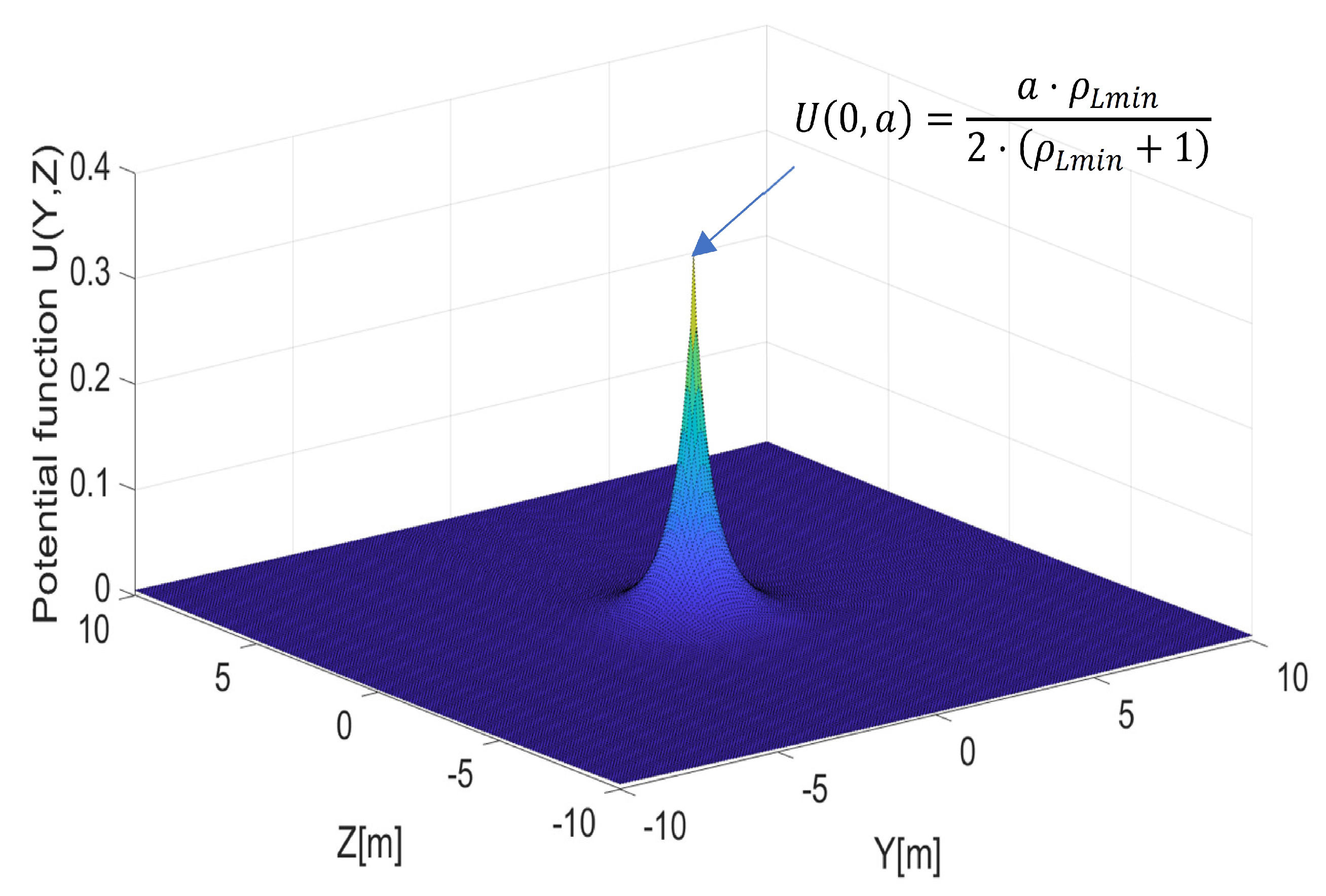
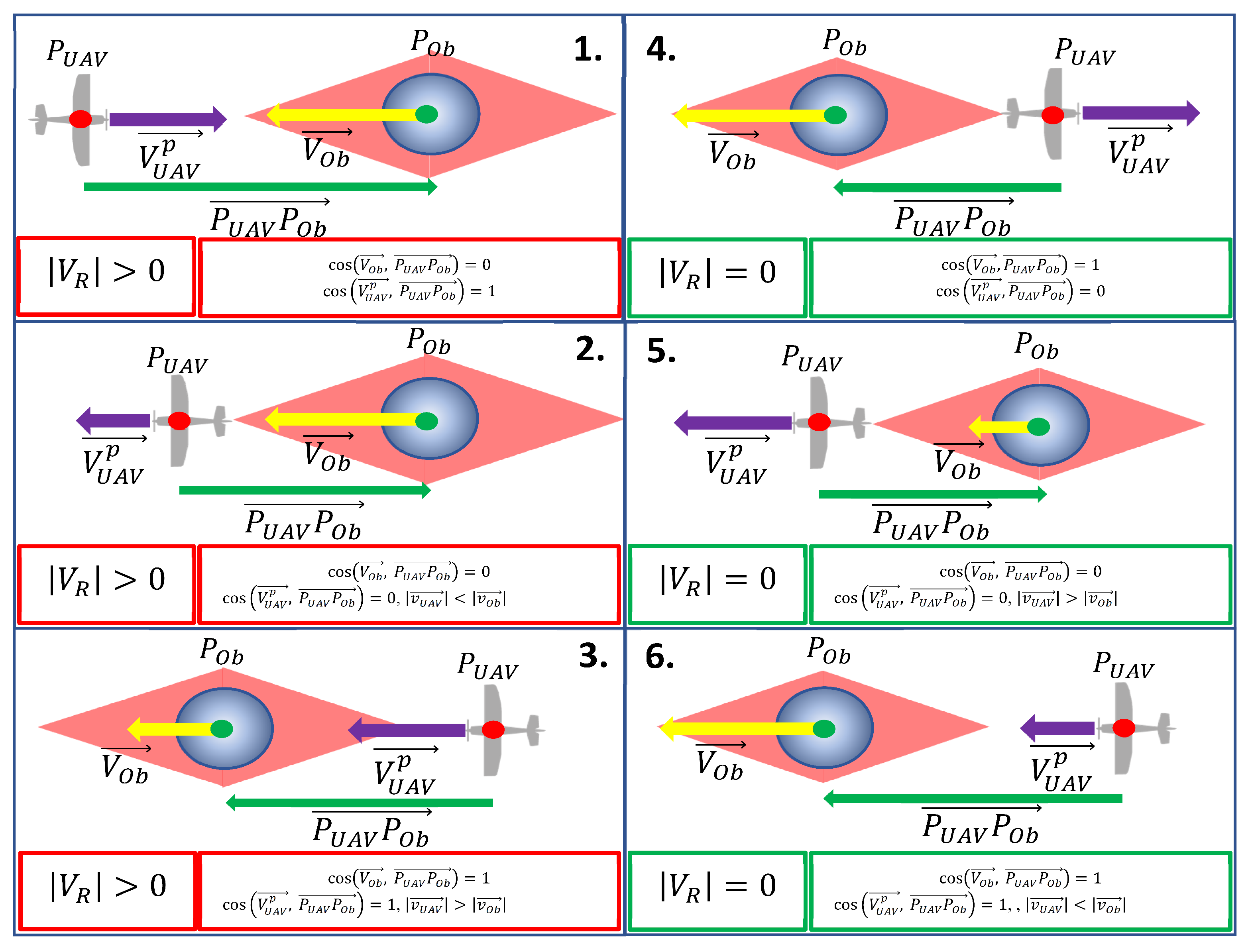
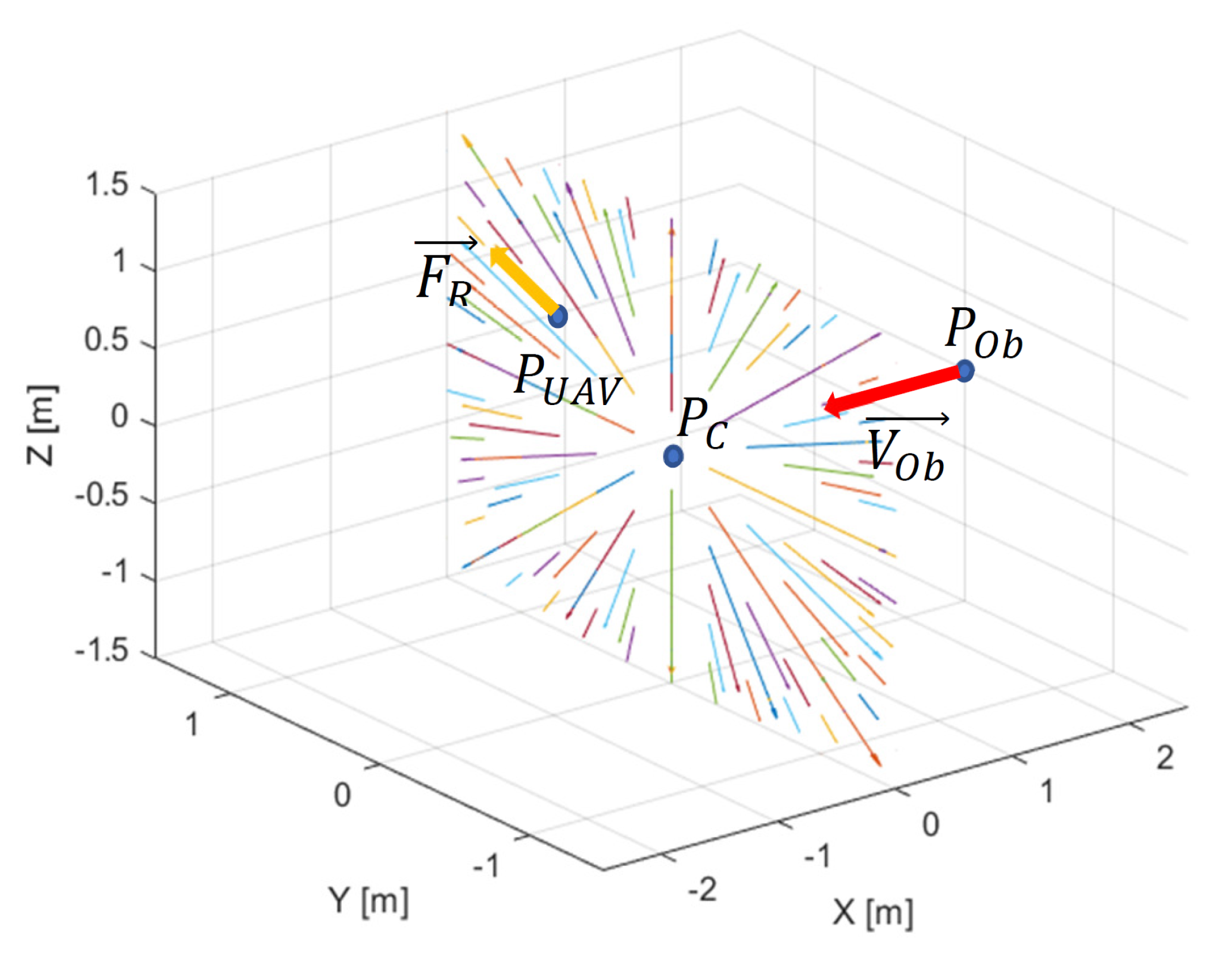
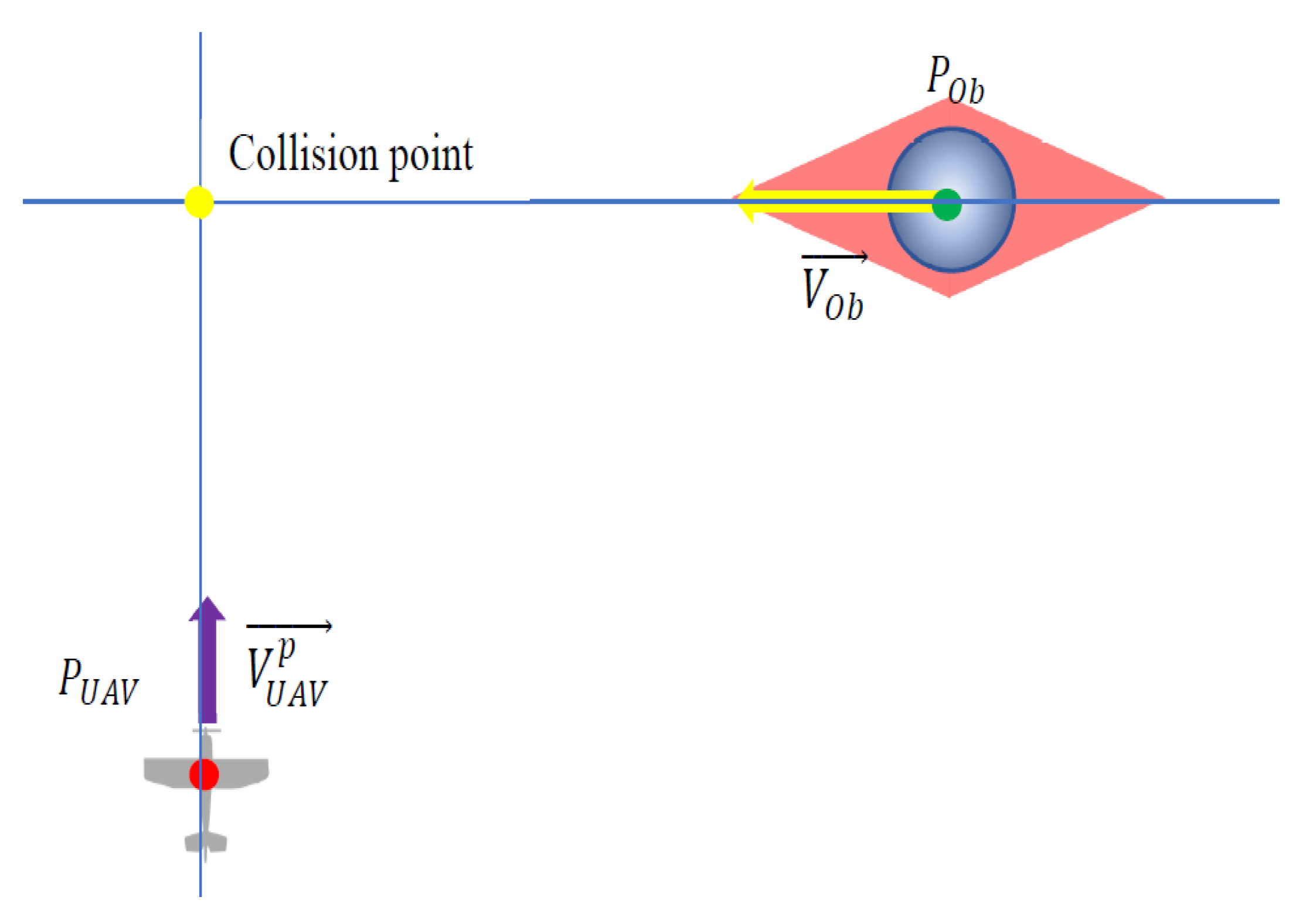
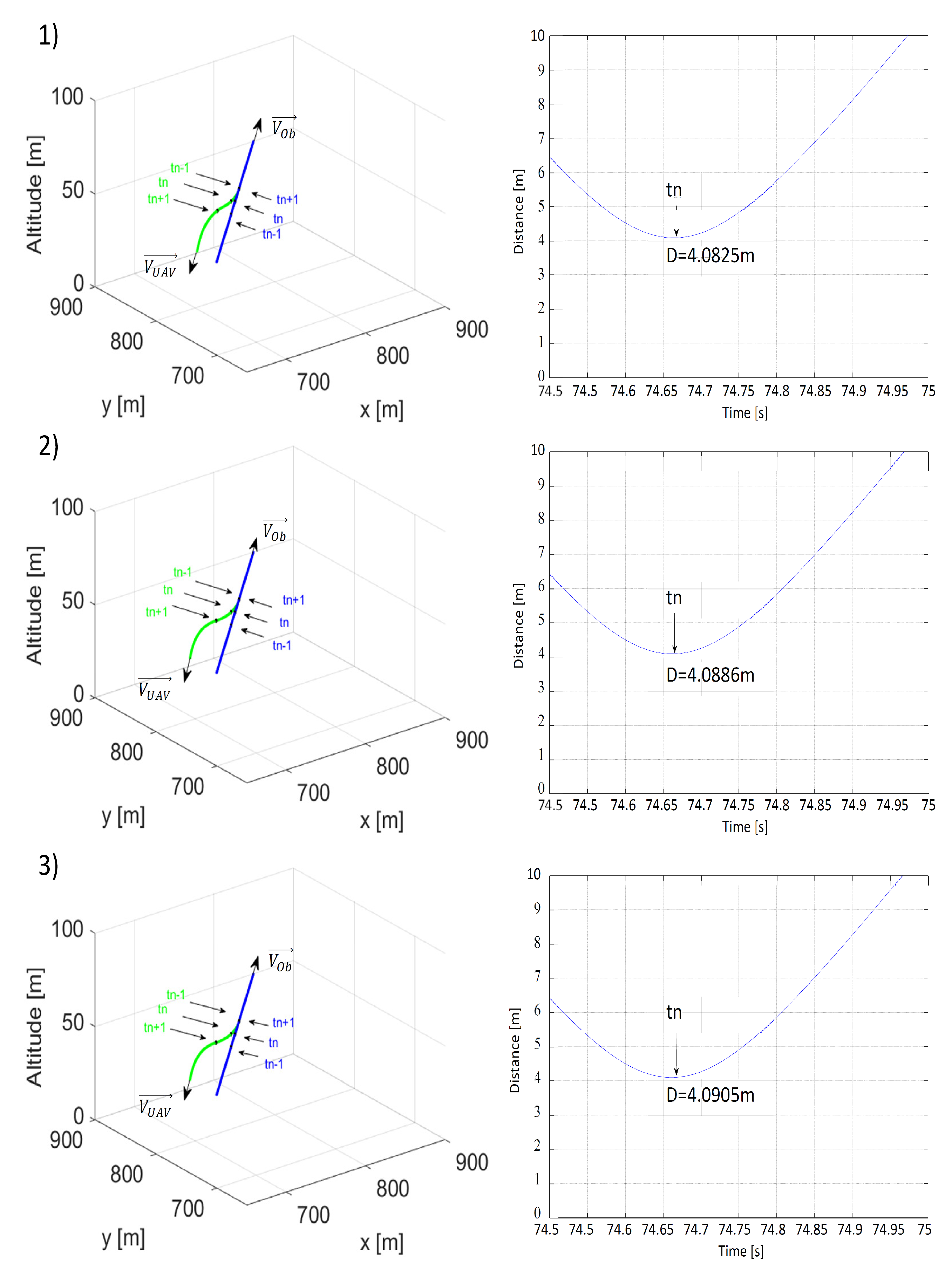
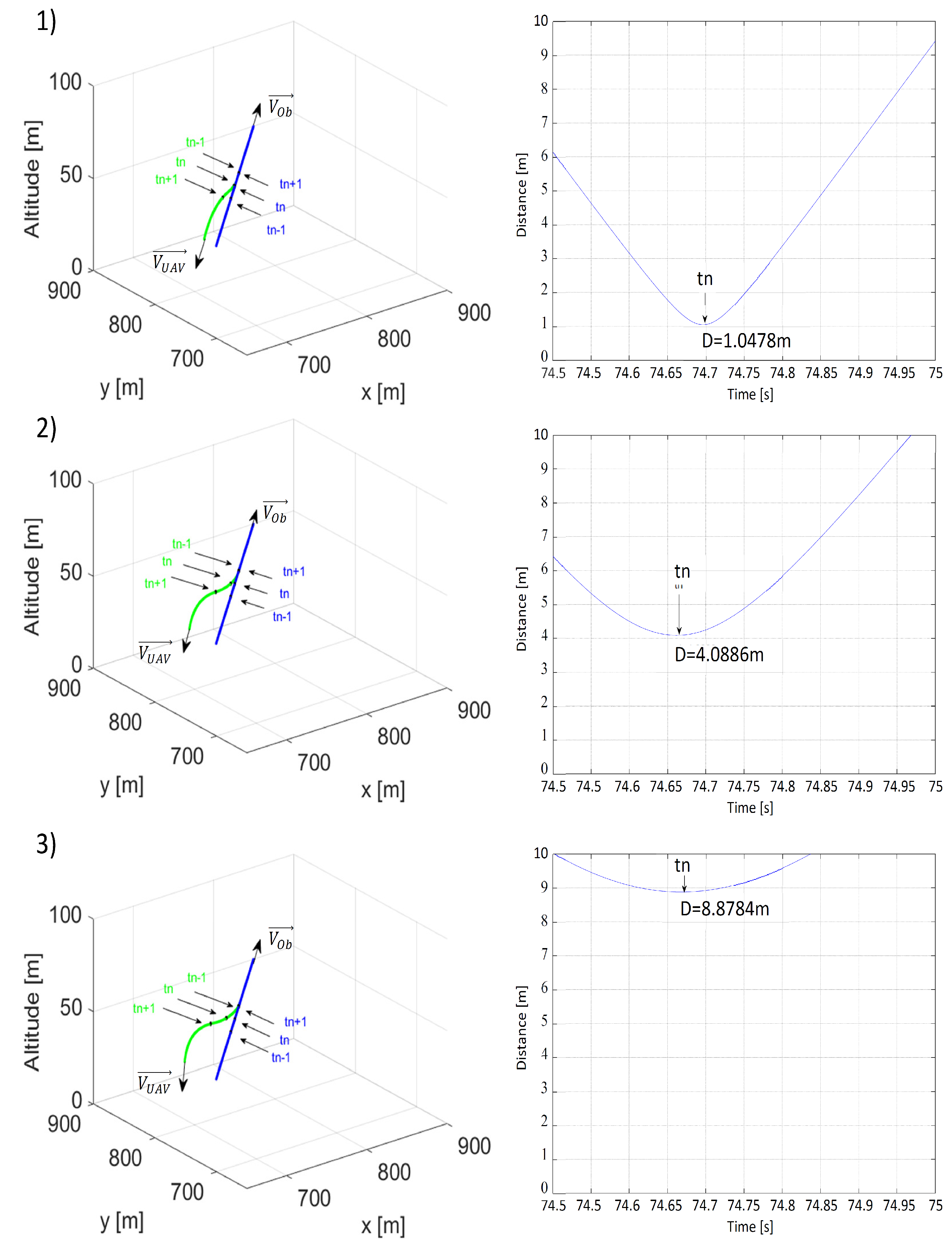
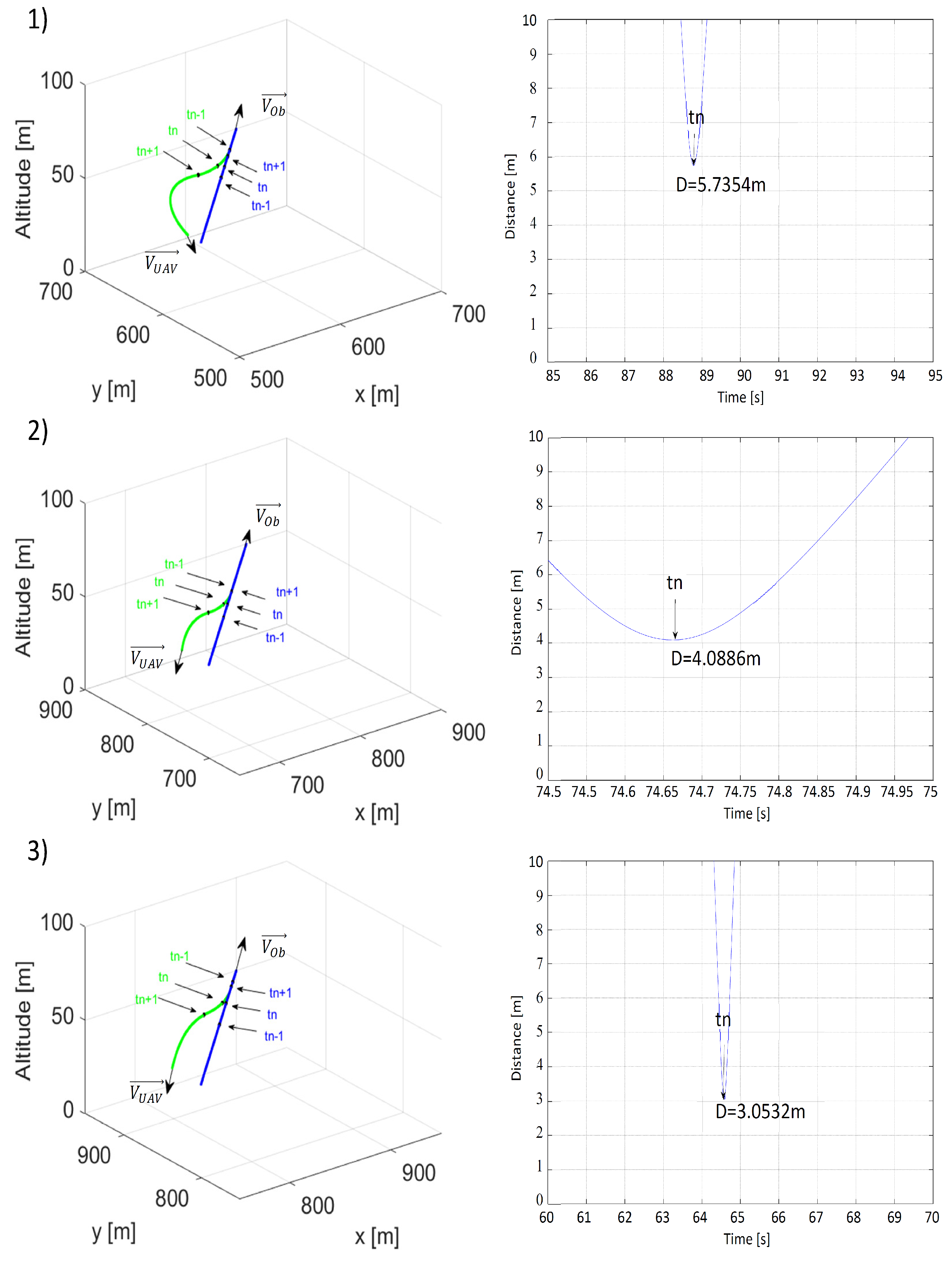
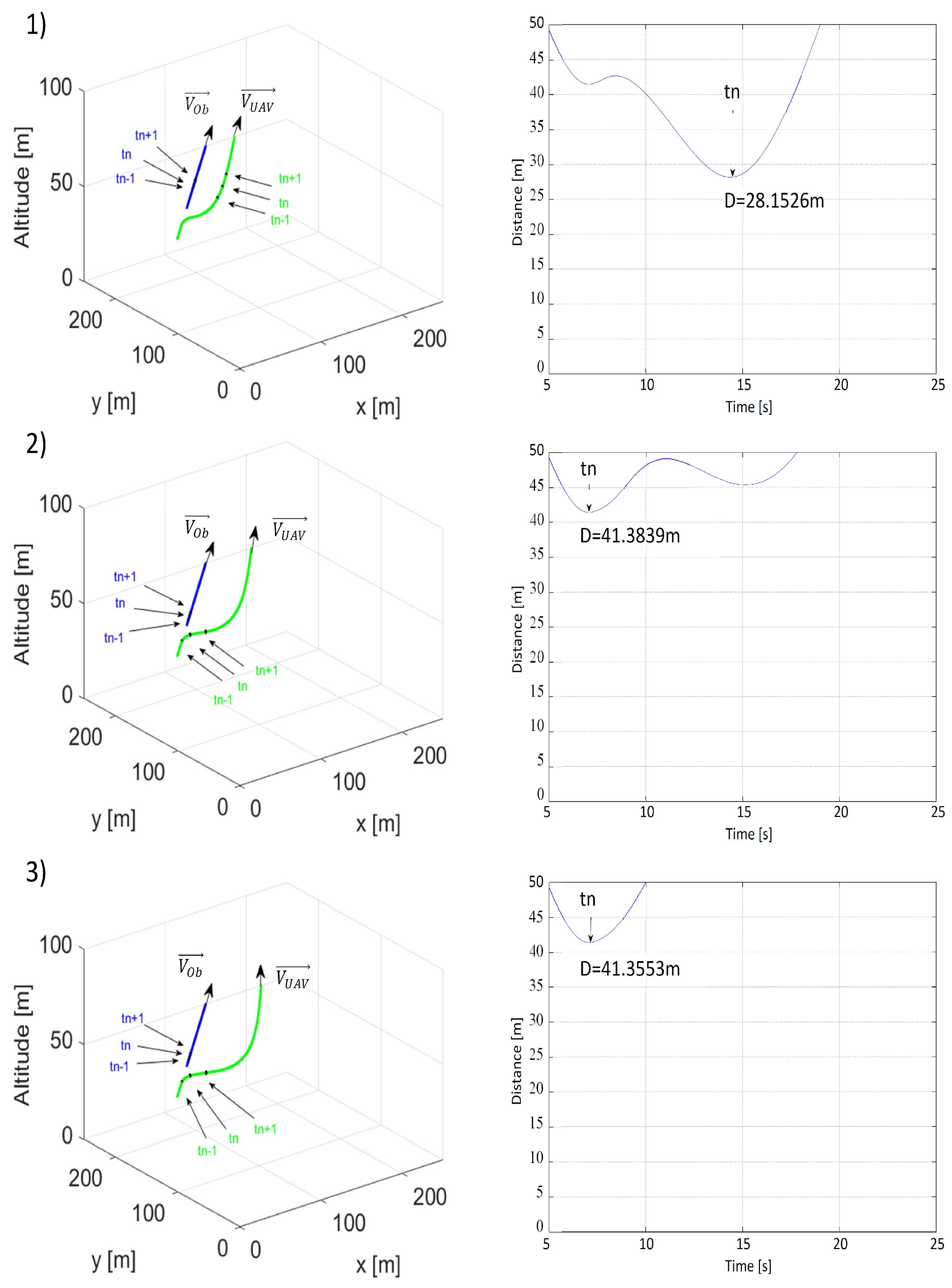
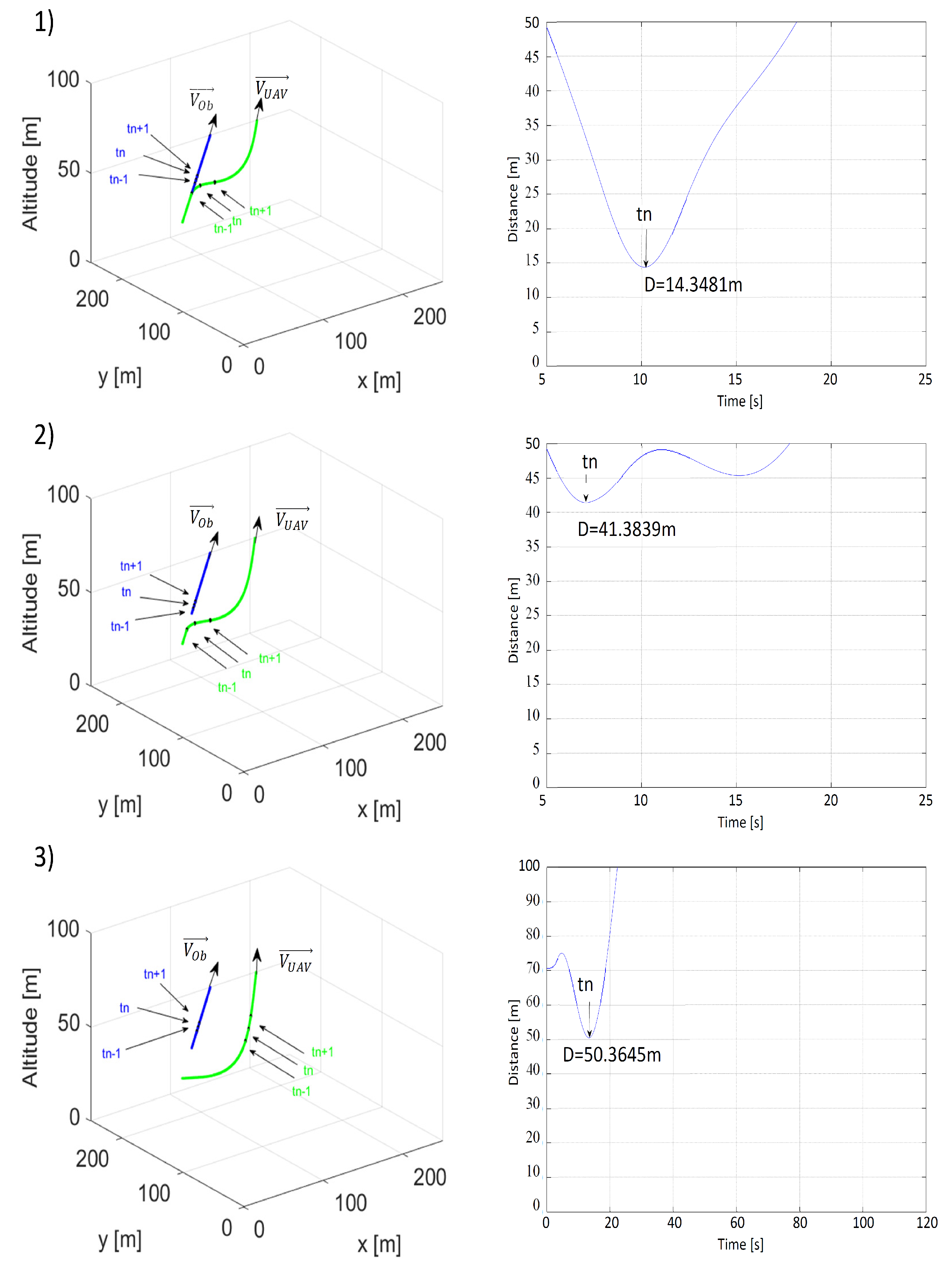

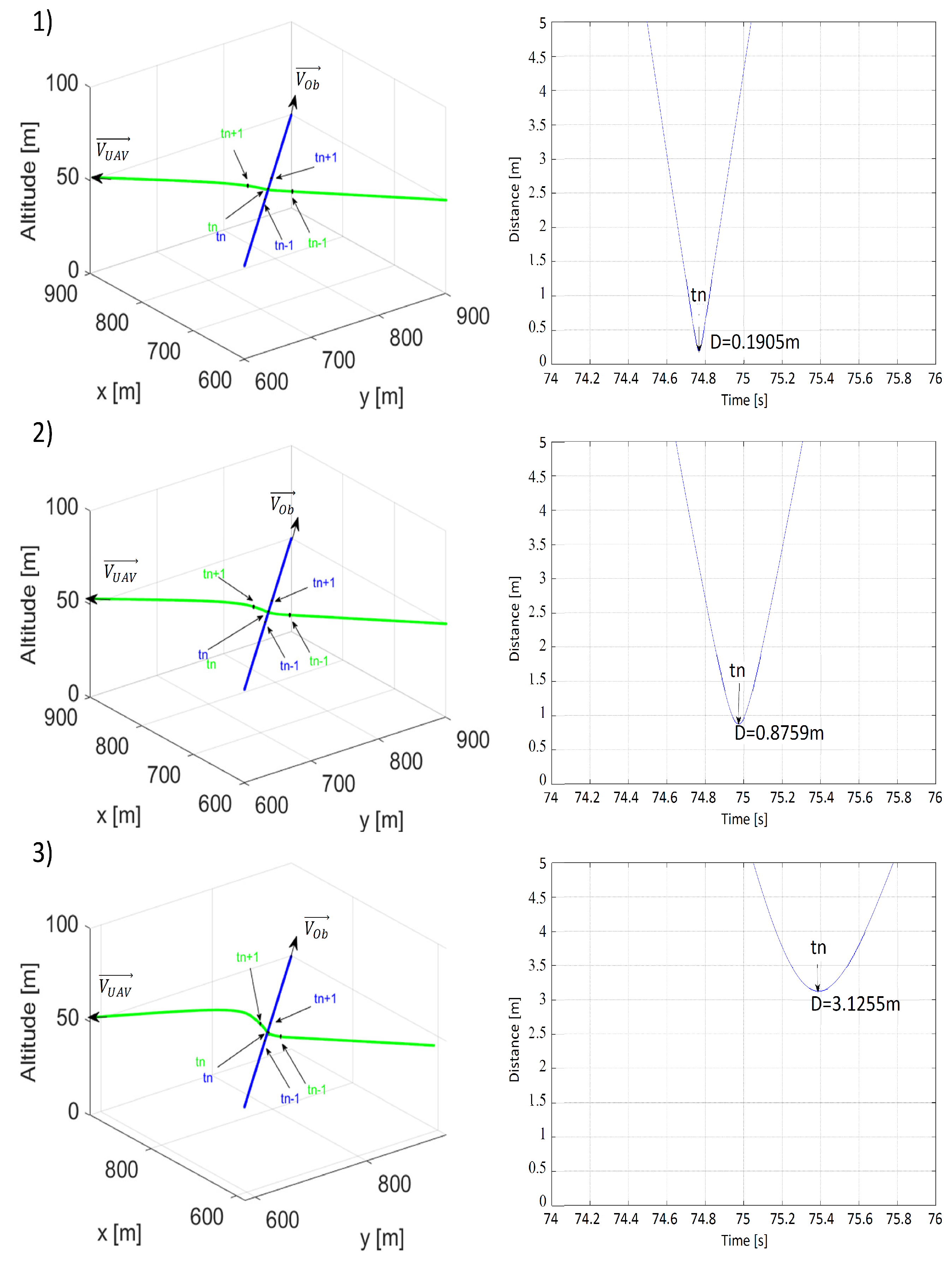
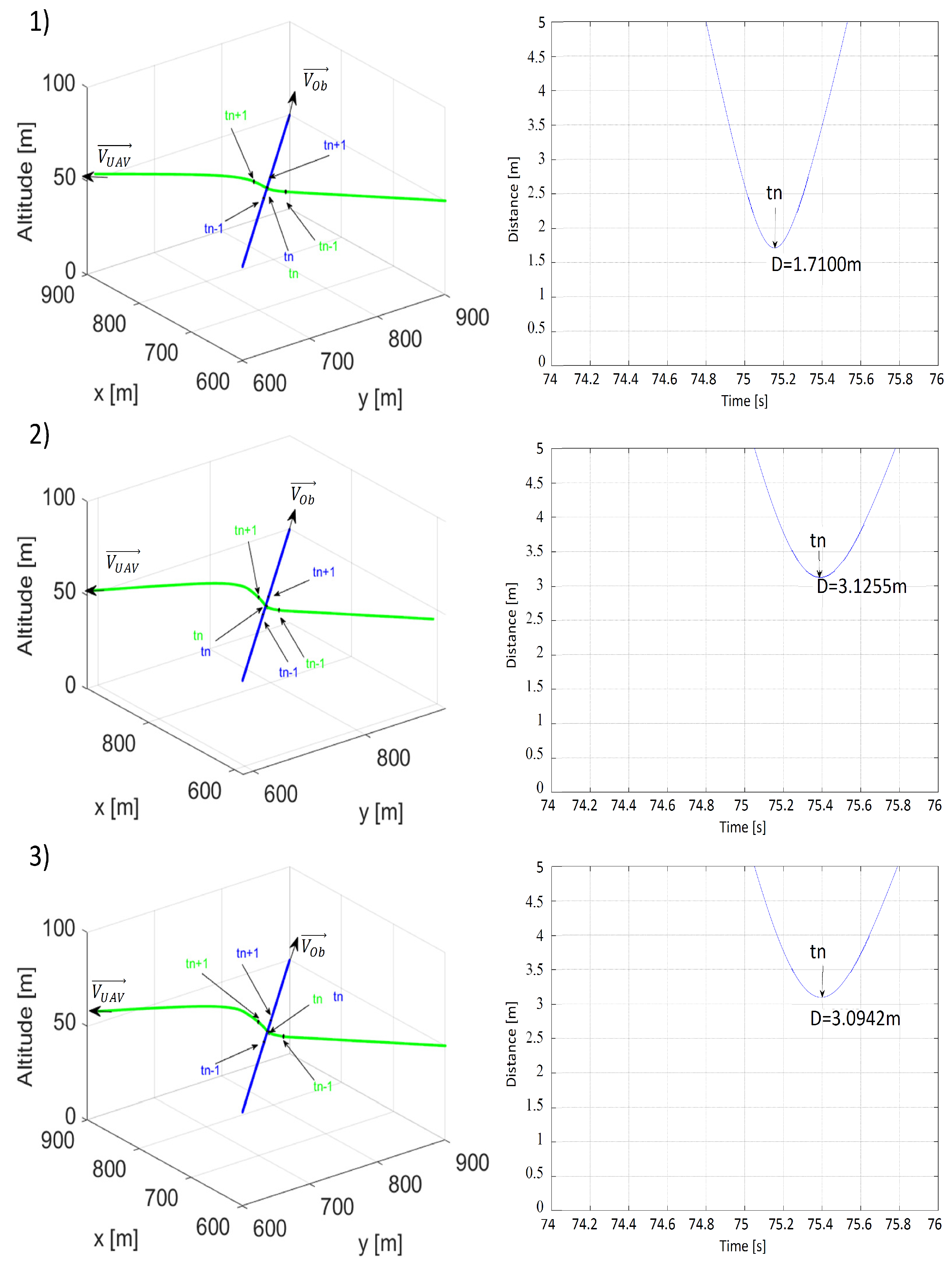
| = 10(1); 15(2); 30(3), = 15 | = 10 m | = 20 m | = 30 m |
|---|---|---|---|
| = 25 m | - | 1.0478 m(2) | - |
| = 50 m | 4.9825 m(2) | 5.7354 m(1) 4.0886 m(2) 3.0532 m(3) | 4.0805 m(2) |
| = 75 m | - | 8.8784 m(2) | - |
| = 0 (1); 10(2); 15(3), = 15 | = 10 m | = 20 m | = 30 m |
|---|---|---|---|
| = 25 m | - | 14.3481 m(2) | - |
| = 50 m | 28.1526 m(2) | 11.444 m(1) 41.383 m(2) 34.811 m(3) | 41.3553 m(2) |
| = 75 m | - | 50.3645 m(2) | - |
Publisher’s Note: MDPI stays neutral with regard to jurisdictional claims in published maps and institutional affiliations. |
© 2021 by the authors. Licensee MDPI, Basel, Switzerland. This article is an open access article distributed under the terms and conditions of the Creative Commons Attribution (CC BY) license (https://creativecommons.org/licenses/by/4.0/).
Share and Cite
Kownacki, C.; Ambroziak, L. A New Multidimensional Repulsive Potential Field to Avoid Obstacles by Nonholonomic UAVs in Dynamic Environments. Sensors 2021, 21, 7495. https://doi.org/10.3390/s21227495
Kownacki C, Ambroziak L. A New Multidimensional Repulsive Potential Field to Avoid Obstacles by Nonholonomic UAVs in Dynamic Environments. Sensors. 2021; 21(22):7495. https://doi.org/10.3390/s21227495
Chicago/Turabian StyleKownacki, Cezary, and Leszek Ambroziak. 2021. "A New Multidimensional Repulsive Potential Field to Avoid Obstacles by Nonholonomic UAVs in Dynamic Environments" Sensors 21, no. 22: 7495. https://doi.org/10.3390/s21227495
APA StyleKownacki, C., & Ambroziak, L. (2021). A New Multidimensional Repulsive Potential Field to Avoid Obstacles by Nonholonomic UAVs in Dynamic Environments. Sensors, 21(22), 7495. https://doi.org/10.3390/s21227495






